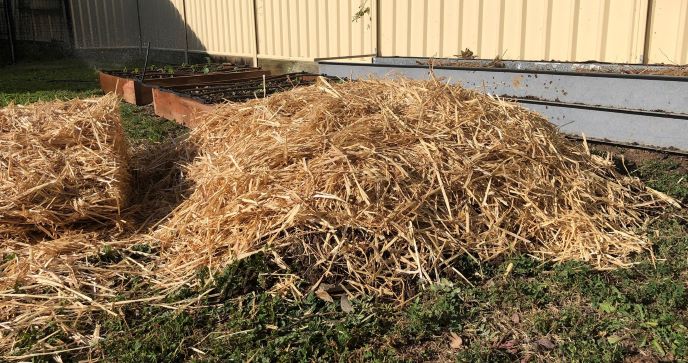Sheet mulching is a form of no-dig gardening, which allows you to build up your soil without hours of back-breaking labour. It consists of Carbon and Nitrogen rich organic materials being stacked on top of the existing soil. Sheet mulching is designed to replicate the natural soil profile. In essence, you are composting in situ, taking full advantage of the rich soil life beneath and saving precious time not having to turn or move it. Once decomposed, sheet mulched beds provide ideal growing conditions for many plants, especially veggies and fruiting plants.
There are countless advantages to sheet mulching, including:
- Using low- or no-cost resources such as cardboard, newspaper, straw, animal manures, compost, and deciduous leaves.
- Preserving the existing soil structure by not having to dig into or overwork it – much of Canberra’s soil is clay, which is prone to damage, especially if cultivated when it is too wet or dry.
- Sheet mulching smothers out weeds, eliminating the need to apply herbicides or hand weeding.
- Sheet mulched beds are raised and therefore have excellent drainage and air-filled porosity. This equates to optimum plant growth.
- The rich organic layers provide excellent nutrition and moisture retention.
What you will need:
- Nitrogen and Carbon rich ingredients. Nitrogen ingredients are commonly known as greens and are things such as compost and aged manures; Carbon ingredients are commonly known as browns and are things such as straw and deciduous leaves (larger leaves need mulching beforehand).
- Garden lime or preferably Dolomite lime, for sprinkling on top of the Nitrogen layer. Lime assists with reducing acidity and the decomposition of the layers.
- Blood and bone or other high Nitrogen ingredients such as a rich slurry of worm tea. This is for the base layer to aid the decomposition of any weeds and grasses.
- Water to encourage decomposition of the layers and to support essential soil life.
- A sturdy garden fork for aerating the ground and building the bed.
Building your sheet-mulched bed:
- Mark out the bed using stringline, pegs and marker paint.
- Sprinkle the surface with blood and bone and Dolomite lime. Water in well.
- Aerate the bed with a garden fork, to help activate soil life and help prevent water runoff.
- Apply an overlapping layer of cardboard or newspapers. Water in well so it doesn’t blow away or wet before laying.
- Apply a 10cm layer of compost and sprinkle with Dolomite. This layer is designed to replicate the soil layer or ‘A horizon’.
- Apply a 10-15cm layer of straw, deciduous leaves or similar. This layer is designed to replicate the forest floor or ‘O horizon’.
- Water in well.
- Let the bed settle for at least several weeks before planting. If planting immediately, plant seedlings into a surround of potting mix to prevent burning the roots.



